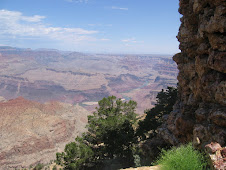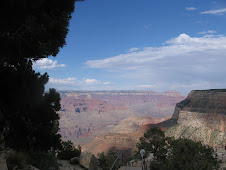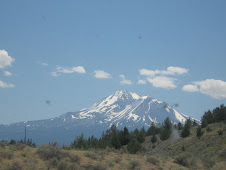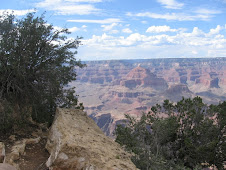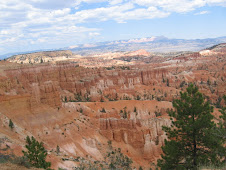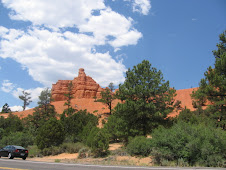The Ucluelet area follows the contours of the rugged west coast of Vancouver Island. Rainforests meet pristine beaches and panoramic views of Barkley Sound and the Broken Islands of Pacific Rim National Park. The trail can be started at either Pacific Rim National Park or near Lighthouse Park. The loop portion of the walk takes you through Lighthouse Park where, on a slightly foggy day, you may hear the lighthouse horn warn boaters to be aware of the rocky shoreline. The trail will eventually follow the outer coast reaching Florencia Bay. This trail is unique and abundant with birds, sea life and wild animals and must be respected as the wilderness park area it is.
The rugged shoreline, as seen from the walking trails, are typical of much of our British Columbia coastline with crashing waves, particularly on the west side of the island. During the winter the breakers may pound the shoreline reaching as high as twenty feet.
On our visit to Ucluelet, the fog horn happened to be blowing although the day was clear. We walked partway along the easy walking trail. Trees permanently bent into interesting shapes, as a result of the heavy winds during winter months, made us stop and admire the power of nature and the resiliency of the trees themselves.
Ucluelet is a popular area for whale watching expeditions. In the spring particularly, the Pacific Rim Whale Festival celebrates the migration of 20,000 gray whales along the coast.
Wickaninnish Centre, outside of Ucluelet is an interesting stop with information on the natural and cultural history of the Pacific Rim. Murals of ocean life and whale bones are on display. Also on display are a whaling canoe and other artifacts of early First Nations peoples' life in the area.
Standing on the outside deck, we got a wonderful view of a quite different shoreline with white sand stretching before us. The surf was high and surfers were enjoying the excitement of catching a wave. There were many warnings to surfers and others to never turn your back on the ocean and to be especially careful around water's edge or while walking on the rocks near the shoreline. Even during calm days extra large waves and rip currents can be lethal.
Like most places in our beautiful province of British Columbia, Ucluelet is a great place to visit.
Wednesday, May 27, 2009
Tuesday, May 26, 2009
The San Juan Island Group
Crossing the border, we traveled down I-5 to Anacortes and took the ferry to Friday Harbor on the San Juan Island. Friday Harbor was somewhat of a surprise to us as it was much larger and more urban than we had expected it to be. Although we were impressed with the town we didn't stop, deciding instead to find a campsite before it got too late.
We booked into the San Juan County Park campground located on the water where the view was lovely but the wind was nearly gale-force at the time we arrived. Because of the increasing winds and the fear of being blown out of our lawn chairs, we decided to take the opportunity to explore the island rather than brave the elements in the camp site. We saw many beautiful areas where huge tumbling waves crashed like thunder onto the beaches and angry black clouds over our heads threatened rain. However, this did not dampen our enthusiasm in discovering what the island had to offer in the way of beauty. Bright yellow and orange flowers growing beside tufts of grass lined the roadside and occasionally a stunted tree, its leaves reaching towards the water, drew our attention from the view of undulating waves.
We explored further the following day, arriving eventually at Roche Harbor. We were enchanted with the village's old buildings; the Hotel De Haro, a brick building where lime and cement had once been made; old brick furnaces and brick walkways. Taking pictures, and reluctant to leave a place where we felt we'd been catapulted back into time, we explored trails through the old lime quarries. At one point we were able to enjoy a beautiful view of the outer islands and our own Canadian gulf islands. We also visited the Krystal Acres Alpaca Farm, a scenic, idyllic home for the obviously well-loved alpacas and their friendly owners.
Having limited time for our trip and wanting to see as much of the Islands as possible, we hurried to catch the ferry to Orcas Island. Camping at Moran State Park, we visited Mount Constitution and climbed the stone observation tower which was built in 1936. Being 2,409 feet above sea level, we had a 360 degree view of the region's islands and mountain ranges as well as some of those in Canadian waters. Within the park also are a couple of interesting moss-covered bridges built in memory of Robert Moran's brother. There are also many hiking trails of varying lengths and on one of these trails we saw several small waterfalls surrounded by lush forests. In many of the areas we walked the forest floors were carpeted with a variety of lush mosses.
Leaving early the following morning, we took the ferry to Lopez Island. On our arrival, we were surprised when we realized that with each car that passed us, there was a friendly wave from its occupant. In no time at all we were returning these friendly waves and wondered why this isn't done everywhere. I particularly enjoyed the rolling farmlands and was interested in the numerous old barns and buildings, the structures often barely supporting the roofs. I found that the old buildings, suggesting many untold stories, situated beside the newer structures were particularly picturesque in their contrast. At each antiquated building we stopped to view, I wondered what the history might have been of the previous families on these farms. We also found a quaint old church with a nearby cemetery; a tranquil scene rarely seen in our world of bustling cars, loaded trucks, public transit and harried people.
Following various roads, we discovered an old unused pier and nearby ancient gas pumps; an interesting bridge built in 1915, spanning an empty pond; old buildings and quaint mailboxes. And without exception, everywhere we went there were friendly people.
On our return we told several friends of our visit to the San Juan Islands and as a result of our enthusiasm, we are sure they will want to check them out for themselves.
We booked into the San Juan County Park campground located on the water where the view was lovely but the wind was nearly gale-force at the time we arrived. Because of the increasing winds and the fear of being blown out of our lawn chairs, we decided to take the opportunity to explore the island rather than brave the elements in the camp site. We saw many beautiful areas where huge tumbling waves crashed like thunder onto the beaches and angry black clouds over our heads threatened rain. However, this did not dampen our enthusiasm in discovering what the island had to offer in the way of beauty. Bright yellow and orange flowers growing beside tufts of grass lined the roadside and occasionally a stunted tree, its leaves reaching towards the water, drew our attention from the view of undulating waves.
We explored further the following day, arriving eventually at Roche Harbor. We were enchanted with the village's old buildings; the Hotel De Haro, a brick building where lime and cement had once been made; old brick furnaces and brick walkways. Taking pictures, and reluctant to leave a place where we felt we'd been catapulted back into time, we explored trails through the old lime quarries. At one point we were able to enjoy a beautiful view of the outer islands and our own Canadian gulf islands. We also visited the Krystal Acres Alpaca Farm, a scenic, idyllic home for the obviously well-loved alpacas and their friendly owners.
Having limited time for our trip and wanting to see as much of the Islands as possible, we hurried to catch the ferry to Orcas Island. Camping at Moran State Park, we visited Mount Constitution and climbed the stone observation tower which was built in 1936. Being 2,409 feet above sea level, we had a 360 degree view of the region's islands and mountain ranges as well as some of those in Canadian waters. Within the park also are a couple of interesting moss-covered bridges built in memory of Robert Moran's brother. There are also many hiking trails of varying lengths and on one of these trails we saw several small waterfalls surrounded by lush forests. In many of the areas we walked the forest floors were carpeted with a variety of lush mosses.
Leaving early the following morning, we took the ferry to Lopez Island. On our arrival, we were surprised when we realized that with each car that passed us, there was a friendly wave from its occupant. In no time at all we were returning these friendly waves and wondered why this isn't done everywhere. I particularly enjoyed the rolling farmlands and was interested in the numerous old barns and buildings, the structures often barely supporting the roofs. I found that the old buildings, suggesting many untold stories, situated beside the newer structures were particularly picturesque in their contrast. At each antiquated building we stopped to view, I wondered what the history might have been of the previous families on these farms. We also found a quaint old church with a nearby cemetery; a tranquil scene rarely seen in our world of bustling cars, loaded trucks, public transit and harried people.
Following various roads, we discovered an old unused pier and nearby ancient gas pumps; an interesting bridge built in 1915, spanning an empty pond; old buildings and quaint mailboxes. And without exception, everywhere we went there were friendly people.
On our return we told several friends of our visit to the San Juan Islands and as a result of our enthusiasm, we are sure they will want to check them out for themselves.
Subscribe to:
Comments (Atom)










































